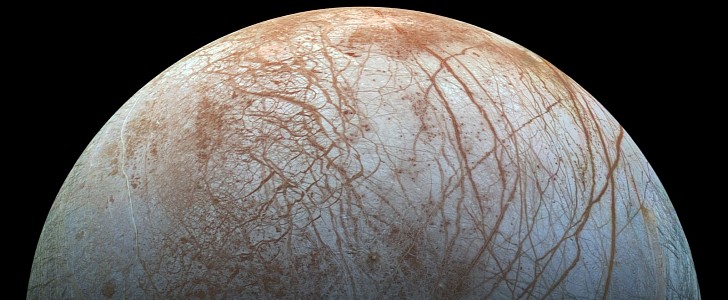NASA's Juno space probe is getting ready for a close-up meeting with Jupiter's icy moon Europa. The solar-powered spacecraft will perform a close flyby that will allow it to snap high-resolution images of the moon's ice-covered surface.
On September 29, the probe will have a close encounter with Jupiter's icy moon Europa. This flyby will provide valuable data to scientists, who believe that there is a hidden ocean beneath the frozen shell, which contains twice as much water as all of Earth's oceans combined. Technically, Europa contains the elements necessary for some form of life, and this makes it one of the more intriguing satellites in the Solar System.
Juno is expected to swoop incredibly close to the moon. More specifically, it will fly at 222 miles (358 km) above the surface of the satellite and snap some sharp images of the frozen surface and collect data on its interior. This will be the closest flyby a spacecraft has performed after the Galileo probe, which came within a distance of 218 miles (351 kilometers) of the moon's icy crust in 2000.
Juno will use its onboard equipment to collect data. For the encounter, the Jupiter Energetic-Particle Detector Instrument (JEDI) and the medium-gain (X-band) radio antenna will be used to gather data on Europa's ionosphere, while the Waves and Magnetometer (MAG) instruments will detect possible water plumes from the moon's surface.
"We have the right equipment to do the job, but to capture a plume will require a lot of luck," said Juno Principal Investigator Scott Bolton. "We have to be at the right place at just the right time, but if we are so fortunate, it's a home run for sure," he added.
The data obtained is crucial since it will not only shed more light on the satellite's composition but will also be used for future missions such as the Europa Clipper. The mission, expected to launch in 2024, will further investigate the moon, helping scientists learn more about the moon's hidden ocean, the ice crust, and any potential plumes that may be escaping into space.
Juno is expected to swoop incredibly close to the moon. More specifically, it will fly at 222 miles (358 km) above the surface of the satellite and snap some sharp images of the frozen surface and collect data on its interior. This will be the closest flyby a spacecraft has performed after the Galileo probe, which came within a distance of 218 miles (351 kilometers) of the moon's icy crust in 2000.
Juno will use its onboard equipment to collect data. For the encounter, the Jupiter Energetic-Particle Detector Instrument (JEDI) and the medium-gain (X-band) radio antenna will be used to gather data on Europa's ionosphere, while the Waves and Magnetometer (MAG) instruments will detect possible water plumes from the moon's surface.
"We have the right equipment to do the job, but to capture a plume will require a lot of luck," said Juno Principal Investigator Scott Bolton. "We have to be at the right place at just the right time, but if we are so fortunate, it's a home run for sure," he added.
The data obtained is crucial since it will not only shed more light on the satellite's composition but will also be used for future missions such as the Europa Clipper. The mission, expected to launch in 2024, will further investigate the moon, helping scientists learn more about the moon's hidden ocean, the ice crust, and any potential plumes that may be escaping into space.





